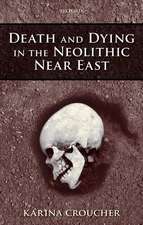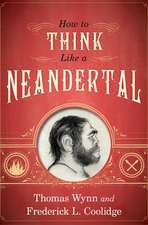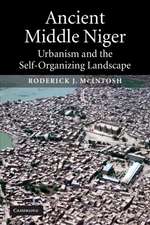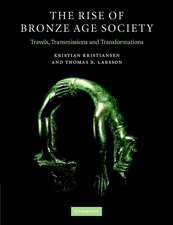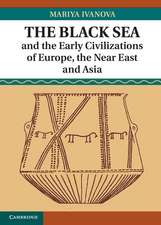The Ecclesiastical Architecture of Ireland, Anterior to the Anglo-Norman Invasion: Comprising an Essay on the Origin and Uses of the Round Towers of Ireland: Cambridge Library Collection - Archaeology
Autor George Petrieen Limba Engleză Paperback – 19 noi 2014
Din seria Cambridge Library Collection - Archaeology
- 19%
 Preț: 542.60 lei
Preț: 542.60 lei -
 Preț: 171.10 lei
Preț: 171.10 lei - 11%
 Preț: 421.60 lei
Preț: 421.60 lei - 19%
 Preț: 599.16 lei
Preț: 599.16 lei - 19%
 Preț: 632.40 lei
Preț: 632.40 lei - 19%
 Preț: 598.08 lei
Preț: 598.08 lei - 19%
 Preț: 556.24 lei
Preț: 556.24 lei - 23%
 Preț: 709.71 lei
Preț: 709.71 lei -
 Preț: 511.85 lei
Preț: 511.85 lei -
 Preț: 326.16 lei
Preț: 326.16 lei -
 Preț: 219.23 lei
Preț: 219.23 lei -
 Preț: 273.71 lei
Preț: 273.71 lei -
 Preț: 236.81 lei
Preț: 236.81 lei -
 Preț: 460.62 lei
Preț: 460.62 lei -
 Preț: 529.08 lei
Preț: 529.08 lei -
 Preț: 441.29 lei
Preț: 441.29 lei -
 Preț: 457.19 lei
Preț: 457.19 lei -
 Preț: 360.98 lei
Preț: 360.98 lei - 19%
 Preț: 452.56 lei
Preț: 452.56 lei -
 Preț: 372.06 lei
Preț: 372.06 lei -
 Preț: 514.14 lei
Preț: 514.14 lei -
 Preț: 459.67 lei
Preț: 459.67 lei -
 Preț: 223.18 lei
Preț: 223.18 lei - 19%
 Preț: 566.10 lei
Preț: 566.10 lei -
 Preț: 364.77 lei
Preț: 364.77 lei -
 Preț: 461.16 lei
Preț: 461.16 lei -
 Preț: 218.64 lei
Preț: 218.64 lei -
 Preț: 275.05 lei
Preț: 275.05 lei -
 Preț: 276.73 lei
Preț: 276.73 lei -
 Preț: 458.71 lei
Preț: 458.71 lei -
 Preț: 361.41 lei
Preț: 361.41 lei -
 Preț: 413.23 lei
Preț: 413.23 lei -
 Preț: 511.11 lei
Preț: 511.11 lei -
 Preț: 372.92 lei
Preț: 372.92 lei -
 Preț: 363.45 lei
Preț: 363.45 lei -
 Preț: 370.35 lei
Preț: 370.35 lei -
 Preț: 217.89 lei
Preț: 217.89 lei -
 Preț: 514.32 lei
Preț: 514.32 lei -
 Preț: 466.39 lei
Preț: 466.39 lei -
 Preț: 349.67 lei
Preț: 349.67 lei -
 Preț: 461.16 lei
Preț: 461.16 lei
Preț: 443.53 lei
Preț vechi: 547.56 lei
-19% Nou
Puncte Express: 665
Preț estimativ în valută:
84.92€ • 88.43$ • 70.46£
84.92€ • 88.43$ • 70.46£
Carte tipărită la comandă
Livrare economică 13-27 februarie
Preluare comenzi: 021 569.72.76
Specificații
ISBN-13: 9781108079860
ISBN-10: 1108079865
Pagini: 552
Ilustrații: 256 b/w illus.
Dimensiuni: 178 x 254 x 28 mm
Greutate: 0.94 kg
Editura: Cambridge University Press
Colecția Cambridge University Press
Seria Cambridge Library Collection - Archaeology
Locul publicării:Cambridge, United Kingdom
ISBN-10: 1108079865
Pagini: 552
Ilustrații: 256 b/w illus.
Dimensiuni: 178 x 254 x 28 mm
Greutate: 0.94 kg
Editura: Cambridge University Press
Colecția Cambridge University Press
Seria Cambridge Library Collection - Archaeology
Locul publicării:Cambridge, United Kingdom
Cuprins
Preface; 1. Erroneous theories with respect to the origin and uses of the round towers considered; 2. True origin and uses of the round towers; Index.
Descriere
Reissued in its 1845 second edition, this work proposed theories that have been refined yet broadly accepted in Irish archaeology.

